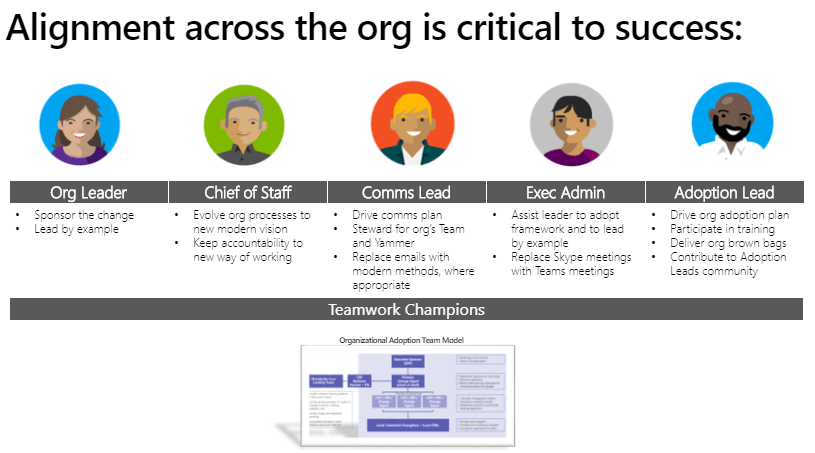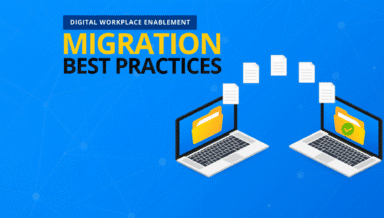Make the Move: How to Efficiently Transition Users from Skype to Microsoft Teams

Struggling to manage your organization’s Microsoft Teams and Office 365 Groups? Download our free ebook for effective strategies and solutions.
Ready for the next step? Reference our recent blog post “Quick Guide: How to Plan an Upgrade From Skype to Microsoft Teams” for help.
As Microsoft continues to encourage organizations to transition from Skype for Business to Microsoft Teams, the time to plan an effective adoption strategy is now! Organizations today may be unsure of what the options are and where to start, but this guide will provide all the answers you need to successfully transition your organizations from Skype for Business to Microsoft Teams!
Technical Support for Transitioning Users
When it comes to the technical side of sunsetting Skype for Business and transitioning users to Microsoft Teams, you need to consider (in addition to what your different options are along the journey) how interop works between those two environments, and what that ultimately feels like for the users? You also need to consider how the transition effects admins. How do you deal with this on a user by user, group by group basis? We’ll dive into all of this!

There are three phases for using Skype for Business and Microsoft Teams side-by-side. Microsoft will sometimes call them coexistence modes, and when they say coexistence, they’re referring to the coexistence between Skype for Business and Microsoft Teams as a user.

In the first mode, you would use Skype for Business and Microsoft Teams side by side. You would have full functionality for both. Then you’ve got options to go all-in on a single client—in this case, Skype for Business. So, if you’re still Skype for Business-only and not ready for Teams yet, this is where you begin your journey.

Another option is to go phased with no functionality overlap. In this case, again, you’ll be starting with Skype for Business. You’ll still have all your workloads on Skype for Business, but with Microsoft Teams added in for the collaboration element. This means there would be no audio, no video, and no meetings in Teams; it would only be used for channels, chat, files, bots.
Though this isn’t quite as sexy as it might sound since I’m just adding one piece of functionality, there’s still huge business value in this. This is where teams can understand the business value of Microsoft Teams. If your organization can see the value in this phase you’ll add the business value of global teams working together on the same file at the same time.
So, in this functionality, everything in the middle box (your calls, your meetings, etc.) are still on Skype for Business. It helps everyone get used to collaboration in Microsoft Teams. It gets users comfortable with the concept, which then makes the move to Teams-only that much easier!

Another option for phased mode is something you‘ll hear Microsoft talk about as “Meetings First.” This is a slightly different variant on phases, and it’s being picked up increasingly by Skype for Business server customers. You may want to slow down the process of transitioning to Teams but still want to take advantage of meetings in the cloud because of the unique offerings of cloud-based recording. For that purpose, you can light up Teams for collaboration and meetings. Skype for Business is still there for direct chat and telephony, but Teams is now the only icon in Outlook to create meetings.
WATCH THE WEBINAR:
Make the Move from Skype to Teams
This option is really good for those that want to get the modern meeting experience but have rolled out lots of Skype for Business server gateways and phones and just aren’t ready to make that leap to the cloud yet, but want to get some business value out of Microsoft Teams today.
How Microsoft Transitioned 200,000 Users from Skype to Teams

When we talk about our Microsoft Teams journey, we really wanted to talk about three key factors. Despite using the clear benefits of Microsoft Teams, making change is still hard. Creating excitement around a new Microsoft technology, especially at Microsoft, is really difficult, so we had to take a thoughtful approach in this. We had to really think about: What’s the value proposition for our users?
Technical Readiness
When we first began the process of transitioning users to Microsoft Teams, we had to make sure we built trust with everyone. We did so by making sure that we were technically ready and had all the features that everyone needed on a day-to-day basis. The product needed to meet the needs of our users or else adoption would have been even more difficult.
To ensure a smooth transition, we used Microsoft Teams in a side-by-side mode with Skype for Business for a long time to get users used to the Teams platform. We used both for collaboration for a long period of time.

Community Advocates and Adoption
Once we felt that we had a user-validated experience, we defined MVPs for Teams. We worked closely with the product group to ensure that everything was properly in place. Shout out to the product group, our service engineers and my team! We could not have been done this without them.
This was truly a shift in how we work at Microsoft, and we really came together to build this one culture to ensure that we’re ready, both technically and with winning the hearts and minds of our employees through adoption. Since I work in the end user services engineering group, I’m always looking at: what does that end user experience look like? What is this going to do? Is it simple? Are we creating productivity? How are we going to benefit? This was very important for us to validate.

Sponsorship and Personalization
The third thing that was really critical for us was sponsorship and personalization for end-users. This included enabling and seeing the impact of everyone transitioning to Teams. We had to make sure that we had organization leaders that were on board throughout this process.
We developed adoption toolkits for the leaders to send out and said, “Here’s your digital toolkit. You need to use this. Here are communications that we’re sending out. Here are your metrics. This is where you are.” We had to show our organization leaders who were using what, like meetings and chats. We had to look at the numerous actions.
This post is taken from a recent webinar from Microsoft’s Pouneh Kaufman, Modality Systems’ Tom Arbuthnot, and AvePoint’s Dux Raymond Sy. You can find the original webinar here.



